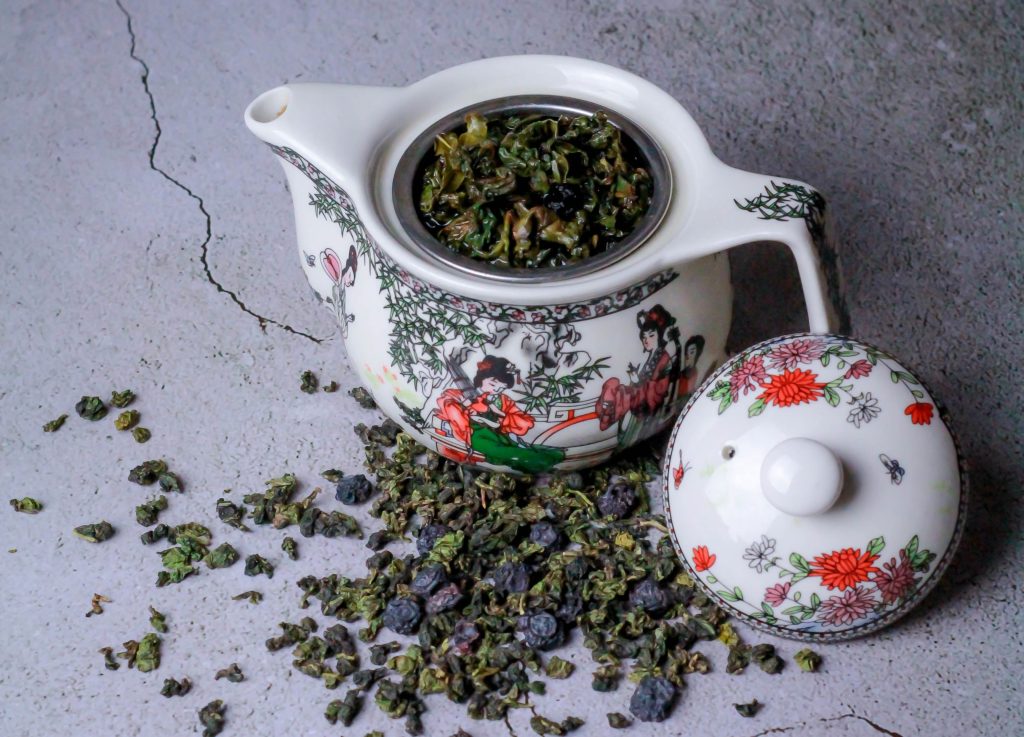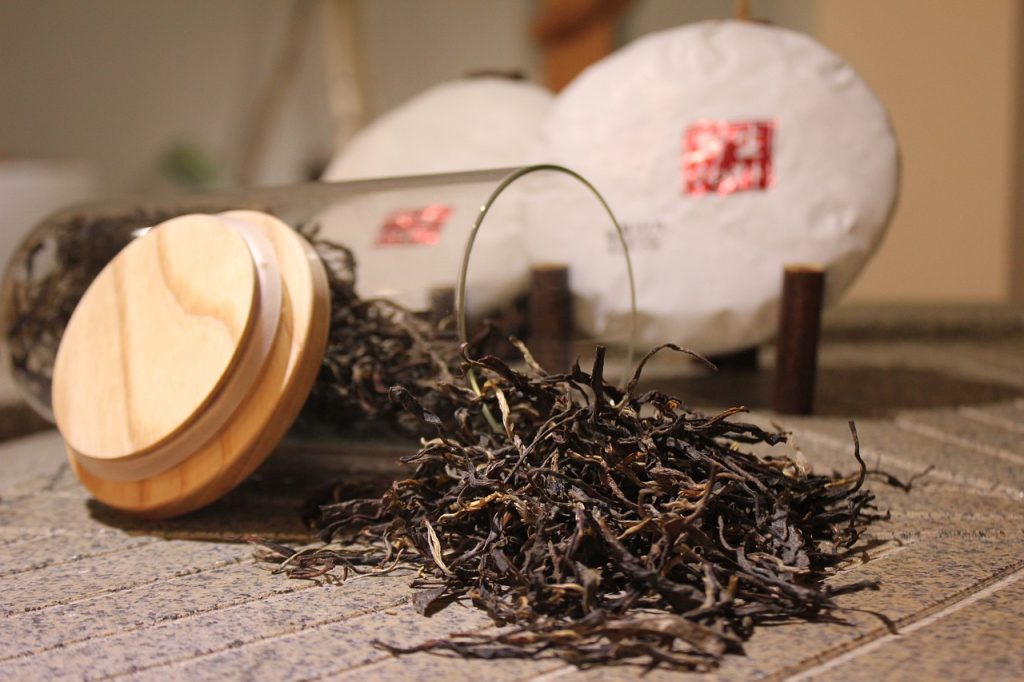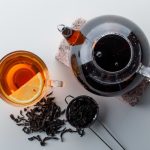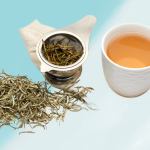What is Oolong Tea and what are its benefits?
Oolong Tea, with its distinctive characteristics and rich history, has become exponentially more popular around the world. This semi-oxidised tea offers a wide range of flavours and health benefits.
In this post, we will transport you to Taiwan and take you to learn about this fascinating tea, its origins, benefits, and advantages.
Keep reading to find out more!

What is Oolong Tea
Oolong Tea (wūlóng) is one of the most complex Chinese teas, made from the Camellia sinensis plant (the same used for all other true teas, such as white, yellow, green, black or pu’erh). Its theine content is generally lower than black tea and similar to green tea. However, each tea is different. In general, you can count on about 20 to 30 mg of theine per cup.
The name “Oolong” means “black dragon” in Chinese. It is believed that its name comes from the appearance of the leaves after being processed.
Oolong lies between green tea and black tea in terms of oxidation. Depending on the processing method, they will be closer to green teas or black teas. In Chinese culture, semi-oxidised oolong teas are known as qīngchá (bluish green tea). Several of its sub-varieties, including those produced in the Wuyi Mountains in the northern part of Fujian Province and the central mountains of Taiwan, are among the most famous Chinese teas.
There are many varieties of Oolong, but, being a tea native to China and Taiwan, it is from there that the main varieties and styles arrive. Of these, three distinct styles of Oolong can be highlighted: “open leaf” style, “semi-rolled ball” style and “strip” style.
What Oolong Tea Tastes Like
It tastes closer to green tea than black tea, as it does not have the characteristic sweetish flavour of black tea. However, it also lacks the vegetal notes typical of green tea. To get those sweet notes, it needs to be prepared strongly, and it’s from the bitter that you get that aroma.
Depending on how it has been processed, it can have highly varied flavours: from floral and fruity to toasted and almond-like. Oolong Tea is typically a journey of flavours and a sensory experience in itself, but each variety also has unique characteristics, such as Tie Guan Yin, Da Hong Pao and Oriental Beauty.

Oolong Tea production
This tea prioritizes mountainous areas to grow, with high altitudes and rocky or sandy soil. These conditions allow for controlled oxidation and dehydration of the leaves. In Chinese culture, the processes of drying and removing moisture are distinct, although to us, they sound similar. This is because they are never completely dried, and there are different stages of production with different moisture levels. Leaf harvesting focuses on the larger leaves, being richer in aromatic oils.
The tea master will determine the state and stage of the process by smell, which requires a keen and sensitive sense of smell.
Oolong tea leaves undergo a two-day osmosis process to release the enzymes required for oxidation. The oxidation time is relatively short, less than for black tea, and is not intended to be complete. To avoid too much oxidation, Oolong tea is heated before being dried. After oxidation, the leaves are rolled and dried.
Its leaves can be rolled into long curved sheets – the oldest method of processing this tea – or spherical, and these processors will yield Oolong teas with different flavours and characteristics.
Oolong tea properties and benefits
Oolong tea contains a small but powerful array of medicinal properties.
The most characteristic is L-theanine, the amino acid that makes this tea a natural calming agent. As a rule, oolong tea has more L-theanine than black tea and less than green tea.
It also has EGCG, a catechin known to aid weight loss, fight cancer, lower cholesterol, reduce blood pressure, and protect the heart and brain.
It was its digestive and cleansing properties that made it famous in the West, due to research into obesity. However, it has been used for centuries by the Chinese for its medicinal properties.
Oolong tea is gluten-free, usually has a strong but not very bitter taste, and has caffeine. Because of its cultural significance, Oolong tea is associated with tea ceremonies from different cultures – such as the Gongfu Cha ceremony in China and traditional Taiwanese ceremonies. These ceremonies are very important for the mental wellbeing of these peoples, and Oolong plays a very rich role in this benign effect.

How to prepare Oolong Tea
- Water temperature: 80ºcelcius
- Infusion time: 2–3 minutes
- Recommended amount: 1 teaspoon per person or 14gr/litre
- Place one teaspoon in a container with 250ml of boiled water (approximately 80º).
- Cover and leave to steep for 2–3 minutes.
- Strain, and it is ready to drink.
It can be drunk hot or cold. However, both forms can be better enjoyed when more specific instructions are followed.
Hot Oolong Tea Preparation
This type of tea is best enjoyed when the leaves are briefly infused when poured over hot water. The leaves may be reinfused several times, which may result in infusions with different characteristics. Oolong tea is served after 1 minute.
Brewing Cold Oolong Tea
Place 6 teaspoons in a heat-resistant jar. Pour 1 cup and 1/4 (250ml) of boiled water and let it infuse for 5 minutes. Fill the jug with cold water, pour in the prepared infusion and add ice. If you prefer this tea sweetened, you can add stevia leaves, caramelized sugar sticks or our organic herring sugar.
Like other pure Camellia sinensis teas, Oolong tea can be enjoyed on its own, or in aromatic herbal teas to taste. If you are curious about this tea and would like to try it, below is our selection of Oolong teas.
Our Oolong
- Oolong Formosa
- Oolong Sechung
- Oolong Secrets of the Forest
- Oolong Goddess of Jasmine
If you like to know more about teas and medicinal plants, and you think this article was useful, share it with your friends and come back often!
Chás do Mundo
“A Somantis, Unip. Lda é uma empresa fundada em 2005 e que atua no ramo alimentar, com especial incidência na importação e exportação de chás, plantas medicinais, acessórios, especiarias e produtos biológicos diversos. A nossa empresa faz-se representar pela marca “Chás do Mundo ®” que apresenta uma vasta gama de chás de elevada qualidade, onde conta com mais de 2000 variedades disponíveis, entre chás ortodoxos ou blends de diversas tipologias como o chá verde, chá branco, chá preto, chá vermelho, chá oolong, rooibos, plantas medicinais, tisanas, misturas de frutas, chás em saquetas simples, biológicos e de comércio justo.”





Sorry, the comment form is closed at this time.